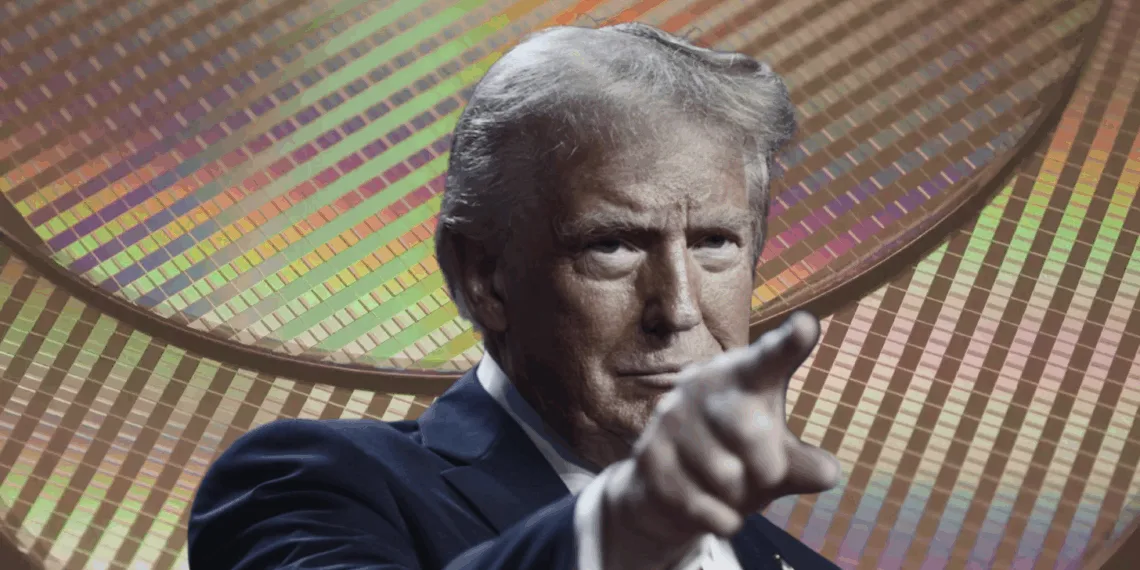Trump’s Plan to Reclaim U.S. Chip Dominance: The semiconductor industry is the backbone of modern technology, powering everything from smartphones to AI-driven innovations. For decades, the United States held the top spot in chip manufacturing, largely due to industry giants like Intel. However, over time, Taiwan has emerged as the leader in global semiconductor production. Now, former U.S. President Donald Trump is making it clear—he wants America to take back control of this critical industry.
In a recent statement, Trump blamed past administrations for allowing the U.S. to lose its grip on chip manufacturing, specifically pointing to Intel’s decline after the leadership of Andy Grove. He believes that through strategic investments and government support, the U.S. can reclaim a significant portion of the semiconductor market. But is this a realistic goal? And what would it take for the U.S. to break free from its dependence on Taiwan and other countries?
Table of Contents
Trump: “We Will Take Back a Big Portion of the Industry”
Speaking from the Oval Office, Trump acknowledged the dominance of Taiwan in the semiconductor space but reframed the issue. Instead of blaming Taiwan for “stealing” the U.S. chip industry, he criticized previous U.S. administrations for failing to protect and support domestic production.
“Andy Grove was a tough, smart guy. And then he died, and there were a series of people who didn’t know what they were doing. Gradually, we lost the chip business. Now it’s almost exclusively in Taiwan. They stole it from us—but I blame the people who let it happen.”
Andy Grove, the legendary former CEO of Intel, was instrumental in establishing the U.S. as a semiconductor powerhouse. His leadership helped Intel innovate and dominate the global market. However, in the years following his departure, Intel struggled with strategic missteps, production delays, and increasing competition from Asian manufacturers. Meanwhile, Taiwan Semiconductor Manufacturing Company (TSMC) steadily rose to become the world’s leading chipmaker.
Trump’s statement highlights a growing sentiment among policymakers—that the U.S. must act fast to revive its semiconductor industry before falling too far behind.
Why the U.S. Lost Its Chip Dominance
The decline of the U.S. semiconductor industry was not an overnight event. Several key factors contributed to this shift:
1. Offshoring & Cost Advantages
One of the primary reasons for the U.S.’s decline in semiconductor manufacturing was the offshoring of production to Asia. Companies found that manufacturing chips in Taiwan, South Korea, and China was significantly cheaper due to lower labor costs and government subsidies.
2. TSMC & Taiwan’s Rise to Power
Founded in 1987, TSMC quickly became the world’s leading semiconductor foundry, manufacturing chips for tech giants like Apple, NVIDIA, and AMD. Taiwan’s government heavily invested in the semiconductor industry, providing infrastructure, tax incentives, and skilled labor, allowing TSMC to surpass Intel in chip innovation and production.
3. U.S. Policy Failures & Lack of Investment
For decades, U.S. government policies did little to support domestic semiconductor production. While other nations provided incentives and funding for their chip industries, the U.S. largely relied on the free market. This lack of strategic investment caused the U.S. to fall behind in chip fabrication capabilities.
4. Delays & Missteps at Intel
Intel, once the undisputed leader in chip manufacturing, faced several setbacks, including delays in adopting smaller nanometer nodes and struggles with fabrication technology. This allowed competitors like TSMC and Samsung to take the lead in producing the most advanced chips.
TSMC’s Expansion: A Step Toward U.S. Chip Independence?
Recognizing the urgency of the situation, the U.S. government has taken steps to bring semiconductor manufacturing back home. One of the most significant developments is TSMC’s $165 billion investment in the U.S.
TSMC’s U.S. Investment Plan:
- Five new chip manufacturing plants in Arizona.
- A state-of-the-art R&D center to develop next-generation semiconductor technology.
- Partnerships with American companies like Intel, NVIDIA, and Broadcom to strengthen U.S.-based production.
While this move is a win for domestic chip production, it doesn’t guarantee U.S. independence. TSMC remains a Taiwanese company, meaning supply chain security concerns persist.

Challenges in Bringing Semiconductor Manufacturing Back to the U.S.
While Trump’s vision of restoring U.S. semiconductor dominance is ambitious, it comes with significant challenges:
1. High Costs & Workforce Shortages
Manufacturing semiconductors in the U.S. is much more expensive than in Taiwan. The cost of labor, land, and infrastructure in the U.S. is significantly higher. Additionally, there is a shortage of skilled semiconductor engineers in the country.
2. Supply Chain Dependencies
Even if the U.S. builds chip factories domestically, the semiconductor supply chain is deeply interconnected. Many raw materials and advanced chip-making equipment come from other countries, including Japan, South Korea, and the Netherlands.
3. Geopolitical & Trade Challenges
Relations between the U.S., China, and Taiwan remain tense. China views Taiwan as part of its territory and has made aggressive moves to control the semiconductor supply chain. Any disruption in Taiwan could have major implications for global chip production.
4. Technology Transfers & Intellectual Property Issues
Bringing semiconductor production back to the U.S. requires technology transfers from companies like TSMC. However, Taiwan has strong policies in place to protect its semiconductor intellectual property, making it difficult to shift production without full cooperation.
What’s Next for the U.S. Chip Industry?
Despite the challenges, there are signs of progress. The U.S. government has introduced the CHIPS and Science Act, which provides $52 billion in subsidies and incentives for semiconductor manufacturing in the U.S. Companies like Intel, Micron, and Texas Instruments are increasing their domestic investments to reduce reliance on foreign supply chains.
Intel’s Comeback: Can It Lead the U.S. Resurgence?
Intel is positioning itself as a key player in America’s semiconductor revival. Under CEO Pat Gelsinger, the company has announced massive investments, including:
- A $20 billion chip manufacturing expansion in Arizona.
- Plans for a $100 billion mega-fab in Ohio.
- A strategic partnership with TSMC to co-produce advanced chips.
Intel’s success will be critical in determining whether the U.S. can regain its position in the global semiconductor market.
Final Thoughts: Can the U.S. Reclaim Chip Dominance?
Trump’s push to reclaim a “big portion” of the semiconductor industry is part of a larger effort to strengthen U.S. technological independence. While TSMC’s investment in the U.S. and Intel’s resurgence signal progress, challenges remain.
For the U.S. to regain its chip dominance, it will require a combination of government incentives, corporate investments, skilled workforce development, and long-term strategic planning.
The coming years will be crucial. Will the U.S. semiconductor industry rise again, or will Taiwan and other global players maintain their lead? One thing is certain—the battle for semiconductor supremacy is far from over.








